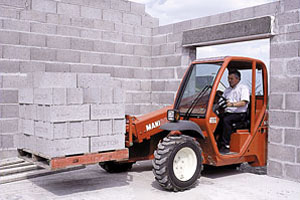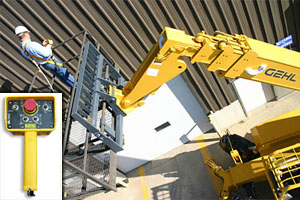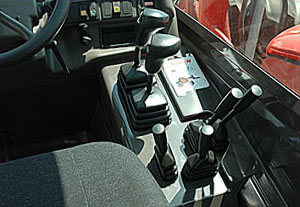Telehandler Trends for 2006... and Beyond
By Brett Martin

Mason contractors looking to add new telehandlers to their fleet have a range of choices in both machines and options this year. Responding to customer demands, manufacturers have delivered larger telehandlers for quickly moving heavy loads, compact telehandlers for easily maneuvering around cluttered job sites, remote-controlled booms for control outside the cab, and GPS systems for tracking maintenance.
"Contractors look for reliability and one that's simple," said John Koepf, product manager for telescopic handlers for Gehl Company in West Bend, Wis. "They want one that's easy to use."
No matter what contractors want, they're sure to find it in this year's breed of telehandlers.
"It's the world's smallest telescopic handler," said Ryan Ford, construction telehandler specialist for the company. "We believe there is a lot of work being done with a skid steer. We're making [a telehandler] that will do the job better."
With an overall height of 75 inches, the telehandler has a short turning radius of only 88 inches and is capable of lifting 3,000 lbs. up to 13 feet.
JLG Industries in McConnellsburg, Pa., has also introduced a lighter weight model with a compact footprint in its G5-19A telehandler. "There's a market for more compact telehandlers," explained David Baxter, the company's director of marketing and market development. "It's probably the fastest growing segment of the industry."
Smaller, shorter and with a narrower width than other telehandlers, it has a 19-foot lift height with a 5,000-lb. capacity.
Compact telehandlers really prove their worth on congested job sites where space is at a premium, Baxter said. "The shorter length helps de-clutter the job site."
Operating with single joystick proportional controls, the G5-19A has three steering modes for changing conditions: front-wheel drive for on the road, all-wheel drive to reduce the turning radius in tight areas, and crab steer for sideways movements and precision positioning before lifting a load.
"If they really don't have to reach the higher heights, then a smaller telehandler can save on their initial investment," Baxter said. "There's probably less wear and tear on the machine, because there's not as many complicated parts and fewer boom sections. It's a simpler machine."
"The XRM1045 is our largest capacity model without outriggers, and has many features and benefits that are standard on all Xtreme telescopic reach forklifts," said Elesha Rasmuson, vice president of administration and sales for Xtreme. "These features include a Perkins turbo-charged diesel engine, 360-degree visibility, robust chassis, foam-filled tires, deluxe suspension seat, improved hydraulics, roller boom, adjustable operator controls, quick attach, full-time planetary four-wheel drive, and service accessibility."
She added that the telehandler also has ergonomic control handles for easy operation and an outlet to charge cell phones. In addition, the boom has heavy-duty steel rollers that reduce wear and require less maintenance.
"All of this really gives you the ability to move more quickly around the job site," Rasmuson said. "You can pick and carry loads quickly and easily."
Servicing the telehandler is also faster and easier. The hood simply slides back to give the technician open access to the engine for routine servicing.
"You slide back the engine cover, and everything is right there," Rasmuson said. "There's no climbing under the machine."

It seems like almost everything has a remote control option nowadays, so why not telehandlers? The remote system eliminates the need for an operator to be inside the telehandler, which allows for a smaller work crew and greater cost savings.
Gehl now offers a radio remote control system that enables the operator to control boom functions from outside the cab, such as on the personnel work platform. A hand-held, wireless transmitter can raise, lower, extend and retract the boom, in addition to starting and stopping the engine.
"This is a revolutionary, timesaving option, especially for roofing and construction contractors," Koepf said. "The remote control system allows contractors to be more productive by not requiring the operator to remain in the cab."
The system uses Frequency-Hopping, Spread-Spectrum (FHSS) technology, which was originally developed for military applications. FHSS devices concentrate their signal power into a narrow band that randomly hops from frequency to frequency within a designated radio band. Each transmitter uses a programmable, unique ID code to ensure multiple systems don't conflict on the job site.
"This allows someone working on a platform to control the boom; otherwise you need someone running the machine from the cab," Koepf said. "You can do work with two people instead of three. It does increase productivity, and that's a big thing."
Currently available on Gehl DL Series telehandlers equipped with the PWP system, the remote control system will soon be offered on its RS Series models with the PWP system.
"It gives you a bigger working area without having to reposition the truck," Ford said, noting that the two systems working together allow fewer crew members to do the same amount of work. "You're removing one person from the equation — the person who would otherwise be inside the truck. It allows them to take a job that would take three guys and do it with two. We're reducing their labor cost."
Gehl is currently developing a 90-degree swing carriage, also for use in conjunction with its remote control system. "This will allow contractors to put the platform or machine parallel rather than perpendicular to the building, then they can work along the edge and cover a larger work area," Koepf said. "It's a greater working environment because it covers a lot bigger area without moving the machine."
Besides saving time by not having to reposition the telehandler for an entire day or more, the work platform will cut down on the time needed to position it in the first place since accuracy is not critical.
"A lot of contractors spend time aligning the platform to the building. With this, you just have to get the platform close," Koepf pointed out. "You're definitely going to make the contractor a whole lot more productive."

Baraga, Mich.-based Pettibone recently released its Maintenance History Tracking System that uses Qualcomm's GlobalTRACS system to keep track of telehandlers' service record, said Dan Blondeau, communications manager for Pettibone.
A GPS-based equipment management system, GlobalTRACS collects and then transmits the telehandlers' information to a datacenter that both dealers and customers can access on the Internet. The system allows dealers to easily locate their machines in the field, track machine hours and utilization rates, monitor unauthorized use, and record the maintenance history, Blondeau said.
"These abilities translate to improved productivity and machine uptime for customers, who benefit from optimally serviced machines," he said. "It keeps them up and running so there's no down time."
The system notifies dealers when the telehandler is ready to be serviced and, from the Internet, they can download a checklist and the interval of service being performed, Blondeau said. The dealer uses the checklist when performing the required service checks and procedures.
"Afterwards, they enter the information online for that particular machine," he said. "What results is a detailed maintenance history on the dealer's entire fleet, which he or she can print or e-mail to their customers."
Blondeau said that, according to equipment auction companies, a detailed maintenance history can increase a telehandler's value by 15 to 20 percent.
Regular maintenance is especially important for mason contractors, who expect their equipment to work hard all day, every day, he said.
"Mason contractors beat up their machines more than any other customers we've seen," Blondeau said. "They beat them into the ground. They run them day and night, so the GPS can tell them when a service is coming up."
The GPS also tells service people where the telehandlers are located, so they can easily find them and plan an efficient route if several need to be serviced in the same day, he said.
"All of the truck functions will be handled with the right hand, so the left hand will do nothing but steer the truck," Ford said.
About the Author
Brett Martin is a freelance writer located in Shakopee, Minn. with several years of construction and writing experience.


















